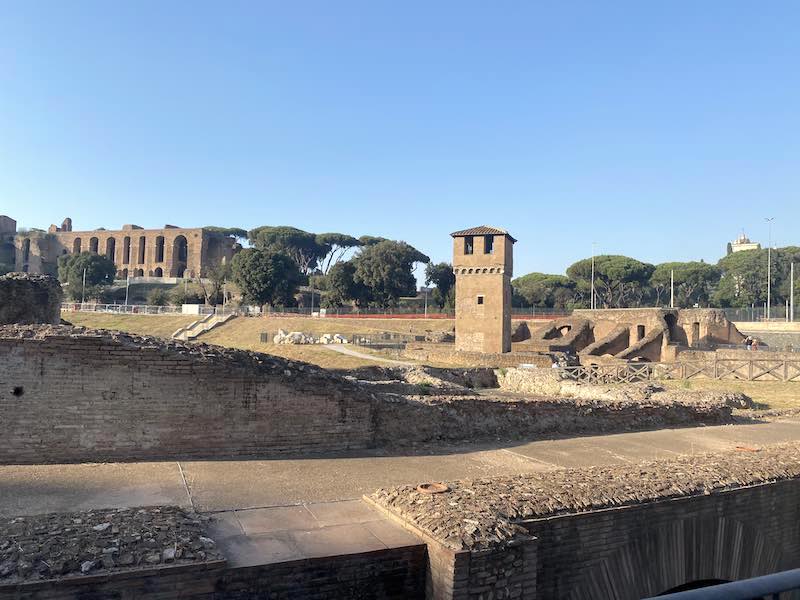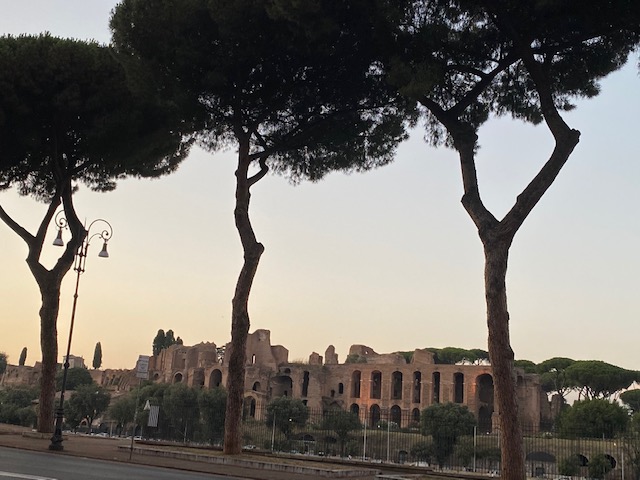Fun and interesting facts about the Circus Maximus, Rome and tips for visiting this ancient roman circus and its scenic location.
The Circus Maximus (Circo Massimo) is an ancient Roman stadium the ruins of which are still visible in Rome city center.
It lies between two of the seven hills of Rome, precisely the Palatine and the Aventine and while there is not a lot of the Circus left to actually see, it is one of the most ancient, scenic and evocative bits of Rome and a place I highly recommend you go see.
From the top of what would have been the stadium seats, you catch a wonderful view over the Palace of Emperors on the Palatine and, from inside the circus itself, you can still gauge the importance and grandeur of the games that it used to host.
I find it one of the best views of Rome and it is free to enjoy!
This is all you need to know to plan a visit to Circo Massimo (Circus Maximus).
Where is the Circus Maximus in Rome: Circus Maximus location and how to get there
Th Circus Maximus / Circo Massimo is in Rome city center, at the back of the Colosseum, between the Palatine and Aventine hill.
Its location was originally called Valle Murcia (Murcia Valley) and its official modern address is Via del Circo Massimo, 00186 Roma RM, Italy.
The Circus is framed by Via dei Cerchi and Viale del Circo Massimo, running along its lengths, and Viale Aventino and Via dell’Ara Massima di Ercole, along its shorter sides.
The circus is served by metro B Circo Massimo, tram 3 and all the buses of Viale Aventino such as 51, 75, 81, 85, 87, 118.
What is close to Circo Massimo?
- The Colosseum and entrance to the Palatine are 5 mins walk away
- Caracalla’s Baths are 5 mins walk
- The Aventine hill is just in front
- The Garden of Oranges is a few minutes up the Aventine hill and so is Rome’s Keyhole
- The Mouth of Truth and the Tiber are a 5-minute walk away, on the other side of the complex of Santa Maria in Cosmedin
- Rome’s Pyramid and the beautiful non-catholic cemetery of Rome are a short walk down the road towards Testaccio
What is special about the Circus Maximus
The Circus Maximus is the largest circuses built in the ancient Roman world and it was a hippodrome/ chariot racing space / wild animal hunting games performance area.
These were popular roman pastimes and attracted very large numbers of spectators.
It is a unique example of Roman Circus, a beautiful spot and, thanks to the most recent reconstructions and the aid of virtual reality, one of the places where you can appreciate the grandeur of Ancient Rome as it must have appeared at the time of its splendour.
A brief history of Circus Maximus
The structure caught the attention of many ancient historians and thanks to their testimony, it has been possible to reconstruct what the Circus must have looked like and the different phases of its construction.

Livy, Suetonius and Dionysius of Halicarnassus, all talked about it, the latter describing it as ‘one of the most beautiful and admirable structures in Rome’ (III.68)
Archaeologists have proof of the existence of construction in this location since the time of the Tarquinii Kings, the last of the seven kings of Rome, who reigned in the VI century BC.
At the time, the circus was an area devoted to the ancient Roman God Consus, an agricultural deity celebrated in August with races of donkeys.
Under Julius Caesar, around the 65BC, the racetrack took the shape we can see now and kept acquiring new areas and decorations under Emperor Titus, whose triumphal arch marked one of the entrances to the Circus and under Trajan.
Since its construction, the Circus saw very many performances and games performed on its large grounds and we know that it remained in use until the VI century.
Chariot races were a very popular form of entertainment in Ancient Rome and lasted for many centuries.
The last known animal game at the Circus Maximus took place in 523AD, and the last known races there were held by Totila in 549AD.
In more recent times, the Circus Maximus hosted Rome gasometer and, in Fascist times, got used as an exhibition space with propaganda installations.
Finally, the Circus returned to be a space for public entertainment: on summer nights, opera shows are performed in the Circus and the new ‘Circo Massimo Experience’ (see below) has now made it a fun and interesting archaeological site in Rome on the main tourist track.
What to expect when visiting Circus Maximus
There are two ways to explore the Circus Maximus:
- Taking a free walk along its long perimeter
- Participating in the Circo Massimo Experience.
A walk around the Circus Maximus was the only way to enjoy this space until 2020, when the ticketed area was established.
The Circus Maximus is open and you visit like you would a piazza: the large circus is accessible by comfortable sets of stairs and you can reach the area where the chariots would have run, now a popular spot for kids and adults resting and having a picnic!
A walks around the Circus Maximus is spectacular but hardly educational. The Circus has fantastic views over the Palace of Emperors on the Palatine and it is one of the best viewpoints in Rome.
However, the Circus has no info panels so you have no way of appreciating how beautiful and imposing it would have been back in the day.
If you can visit the Circus with the Circus Maximus Experience, you truly see the place coming back to life!
The ‘Circus Maximus Experience’ was established in 2020 and it is an immersive experience that uses Augmented reality to show you the Circus as it would have been.
Thanks to the use of headsets that include immersive glasses and stereo audio earphones, the self guided tour brings the visitors along 8 stops/locations in the circus and uses augmented reality to create a rendering of what the place would have been when still standing and in use.
The tour is wonderful. The headsets are easy to use, the reconstructions very impressive and the explanations easy and historically correct.
Thanks to the headset, it is possible to understand that the Circus was a complex space with a racing arena, tramples and statues of deities, a triumphal arch, shops and seats for 250,000 people!
The virtual reality glasses also show the carceres, aka the stalls from where the chariots would start the race, the metae, the two posts art the two ends of the circus that the chariots had to race around and the seating of the judges and the spectators, according to importance and rank.
You can find my full review of the Circus Maximus Experience here.
2021 update: the virtual reality tour of the Circus Maximus is open to the public from 29th April from 5pm to 8 pm. Advanced booking necessary. The Virtual reality Circus Maximus experience lasts 40 mins and it is available in 6 languages. You can find info, dates and prices here.
Is it worth visiting the Circus Maximus?
I believe a visit to the Circus Maximus is worth it however, it is important to know what to expect.

The Circus itself is in a very impressive location and it is worth walking along it and in it to take it its unique size and appreciate its incredible vantage point for views over the Palatine.
However, unless you take the virtual reality experience, this is not an archaeological attraction like Carcalla’s Bath or the Colosseum, with a lot to see or explanatory panels.
It is open-air, scenic, archaeological vestiges that now blend with its surroundings creating a wonderfully and uniquely roman picture-perfect location.
I recommend visiting the circus as part of your itinerary especially close to sunset or to bring the kids here for a good run around in an ancient stadium.
If you are after a romantic location, the view at sunset is one of the most romantic in Rome!
Circus Maximus facts
When was the Circus Maximus built? The origins of the Circus Maximum can be traced back to the VI century BC however, we have information of work done here under Julius Caesar (I century BC), of damaging fires under Emperor Nero (I century AD) and reconstructions under Emperor Trajan (II century AD).
How many spectators could the Circus Maximus host? The Circus is said to have been able to host up to 250,000 people.
How big was the Circus Maximus? The Circus was the largest of all Roman circuses and it measures 621 m (2,037 ft) in length and 118 m (387 ft).
What types of events did the Circus host? The Circus was built to host games such as animal hunts and gladiator games but also specifically chariot races that were an exceptionally popular form of entertainment in Rome.
Occasionally, the stadium was also used for political rallies and even public execution in a way not dissimilar from the later constructed Colosseum.
There is reason to believe the most popular Circus Maximus events were chariot races.
What do we know about the Circus Maximum architecture in origin? The Circus nowadays is a rather low structure, lower than street level, however, at the time it would have been surrounded by arcades somewhat reminiscent of what we need now at the colosseum.
The arcades would have hosted shops (tabernae).
Inside, the Circus had rows of seats organized in several tiers and sections, to separate supporters of different chariot teams, a little like modern stadiums now have different areas for spectators from opposing teams.
The lower tiers were probably made of stone and those farther up were made of wood.
The arena and main stadium track had a central line spina, decorated with obelisks and dividing the stadium in two halves lengthwise, and two metae (turning posts).
12 starting gates marked the starting point for the races and the chariots would have to race and turn around the metae to complete the race and the magistrate signaling the start of the game would have sat just above them
The chariot racers were organized in color-coded teams and stables and we know the most successful of them were kept in very high regard.
Some names that got to us are Pontius Epaphroditus, Pompeius Musclosus and Diocles and Scorpus.
What to bring for visiting the Circus Maximus
You do not need special gear to visit the Circus Maximus.
The view of the Circus and the palaces can easily be enjoyed from the road and the area has several shops and cafes for lunch should you find yourself here at the right time.
The circus itself is now an open air space with a ground od grass and dust so if you want to walk here, runners are best (it is a rather dusty place!). You can find my selection of the best shoes for Rome here.
The sun hits hard here so if visiting in the hot season, a sun hat is a must-have.
If you have a reusable water bottle with you, you can fill it up at the nasone (small drinking fountain, learn about them here) along the Circus’ length.
I hope you enjoyed this quick overview of the Circus Maximus and it inspired you to go visit!
Did you enjoy this post? Save it on Pinterest!

